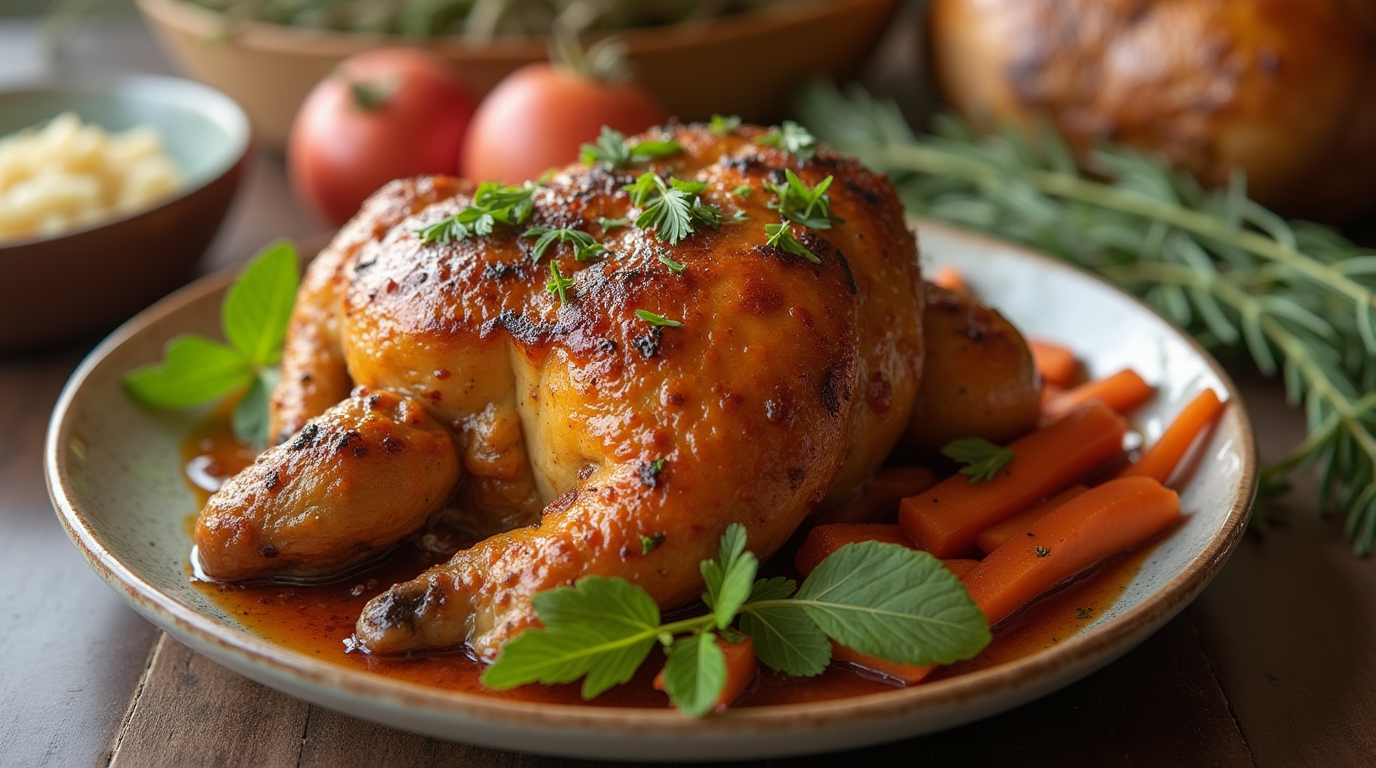Introduction
Imagine coming home after a hectic day, greeted by the irresistible aroma of a meal that’s been simmering all day. Slow-cooked food isn’t just about nourishment; it’s about comfort, tradition, and creating something truly memorable. Whether you’re an experienced cook or just dipping your toes into the world of home cooking, slow cooking opens the door to culinary creativity, simplicity, and deeply satisfying flavors.
This guide will walk you through everything you need to know about slow cooking—from understanding its benefits to mastering techniques and recipes. By the end, you’ll feel confident in using this timeless method to elevate your meals.
Table of Contents
What Is Slow Cooked Food?
Slow cooking is a method of preparing food over a longer period at low temperatures. This technique allows flavors to develop fully and ingredients to meld into a cohesive dish. Historically, it has roots in many cultures, with methods like braising, stewing, and roasting evolving into modern-day slow cooking.
This style of cooking isn’t just about convenience; it’s about unlocking flavors and textures you can’t achieve with faster methods. Whether it’s a hearty stew, tender meats, or a savory vegetarian chili, slow cooking takes ordinary ingredients and transforms them into something extraordinary.
Why You Should Embrace Slow Cooking
Health Benefits
Slow cooking can be a healthier alternative to frying or high-heat roasting. Since this method uses lower temperatures, it helps retain more nutrients in your ingredients. Plus, you can control exactly what goes into your meals, avoiding unnecessary fats, oils, and additives.
For instance, when you prepare a slow-cooked vegetable soup, you preserve the vitamins and minerals that might otherwise be lost during high-heat cooking. Similarly, lean cuts of meat become tender without needing extra oil, making slow-cooked food both nutritious and delicious.
Unmatched Flavor Development
Cooking food slowly allows spices, herbs, and other ingredients to infuse deeply. The result? Dishes bursting with complex, rich flavors that make every bite irresistible.
Think of slow-cooked beef stew. The hours of simmering allow the meat to soak in the broth’s flavors, while the vegetables soften just enough to create a harmonious texture and taste.
Convenience
Life is busy, but that doesn’t mean you have to compromise on quality meals. A slow cooker lets you prepare everything in the morning and come home to a hot, ready-to-eat dish. This hands-off approach saves time without sacrificing flavor.
Essential Tools for Slow Cooking
Slow Cooker
This appliance is a staple in many kitchens. Look for one that fits your needs—whether it’s a compact version for small meals or a larger model for family-sized portions. Features like programmable timers and warming functions make slow cookers even more convenient.
Dutch Oven
A Dutch oven offers versatility. You can use it on the stovetop or in the oven, giving you more control over temperature and browning. It’s perfect for recipes that benefit from a seared crust or slightly reduced liquids.
Other Must-Haves
- Liners: For easy cleanup.
- Meat Thermometer: To ensure food is cooked to safe temperatures.
- Wooden Spoons: Gentle on your cookware and ideal for stirring.
Mastering Slow Cooking Techniques
Choose the Right Ingredients
Not all ingredients are created equal in slow cooking. Tougher cuts of meat, like chuck roast or pork shoulder, thrive in this method because the long cooking time breaks down their fibers, resulting in tenderness. Root vegetables, like carrots and potatoes, hold their shape well during slow cooking, making them ideal for stews and soups.
Layering Flavors
Start with bold flavors by browning your meat or sautéing onions and garlic before adding them to the slow cooker. This step enhances the dish’s overall taste. When layering ingredients, place denser vegetables like potatoes at the bottom and more delicate items like herbs near the top.
Perfecting Time and Temperature
Understanding the right cooking time is crucial. Most slow cooker recipes can be adjusted to cook on high for 4–6 hours or low for 8–10 hours. Low heat is ideal for tougher cuts of meat, while higher settings work well for lighter dishes like soups.
Avoid Common Mistakes
- Don’t Overcrowd: Leave space for heat to circulate.
- Limit Lid Opening: Each peek can lower the temperature and extend cooking time.
- Go Easy on Liquid: Slow cooking doesn’t evaporate liquid as quickly, so use less than you would for stovetop recipes.
Delicious Recipes to Get You Started
Classic Beef Stew
A hearty, crowd-pleasing dish perfect for chilly evenings.
| Ingredient | Quantity |
|---|---|
| Chuck roast, cubed | 2 lbs |
| Carrots, sliced | 3 large |
| Potatoes, cubed | 4 medium |
| Beef broth | 4 cups |
| Onion, diced | 1 large |
| Garlic, minced | 3 cloves |
| Tomato paste | 2 tbsp |
| Thyme | 1 tsp |
| Salt and pepper | To taste |
- Brown the beef cubes in a skillet.
- Layer vegetables in the slow cooker.
- Add the beef, broth, and seasonings.
- Cook on low for 8 hours.
Slow-Cooked Chicken Tacos
| Ingredient | Quantity |
|---|---|
| Boneless chicken breasts | 1.5 lbs |
| Salsa | 2 cups |
| Taco seasoning | 1 packet |
| Corn tortillas | 8 |
| Toppings (cheese, lettuce) | As desired |
- Place chicken, salsa, and seasoning in the slow cooker.
- Cook on low for 6 hours.
- Shred the chicken and serve on tortillas with toppings.
Vegetarian Chili
| Ingredient | Quantity |
|---|---|
| Black beans, canned | 2 cups |
| Kidney beans, canned | 2 cups |
| Diced tomatoes, canned | 3 cups |
| Onion, diced | 1 large |
| Bell pepper, chopped | 1 large |
| Chili powder | 2 tbsp |
| Cumin | 1 tsp |
| Garlic, minced | 3 cloves |
- Combine all ingredients in the slow cooker.
- Stir well and cook on low for 6–8 hours.
Special Occasions Made Easy with Slow Cooking
Slow-cooked food is a lifesaver for holidays and parties. Imagine serving a perfectly tender pot roast for Christmas or slow-cooked turkey for Thanksgiving, all while spending more time with your guests and less in the kitchen.
Tips for Storing and Reheating
- Refrigeration: Store leftovers in airtight containers for up to 3 days.
- Freezing: Freeze in portion-sized containers for up to 3 months.
- Reheating: Reheat slowly on the stovetop or in the microwave, adding a splash of liquid to maintain moisture.
FAQs About Slow Cooked Food
Q: Can I use frozen ingredients in a slow cooker?
Yes, but thawing first ensures even cooking and reduces food safety risks.
Q: What’s the best way to clean a slow cooker?
Use warm soapy water or a vinegar solution for stubborn stains. Liners can make cleanup easier.
Q: Why is my slow-cooked food bland?
Ensure proper seasoning and consider adding fresh herbs or spices in the last 30 minutes of cooking.
Conclusion
Slow cooking isn’t just a technique; it’s a lifestyle choice that brings flavor, convenience, and nourishment to your table. Whether you’re tackling a classic beef stew or experimenting with new recipes, the possibilities are endless. Start slow cooking today, and savor the delicious rewards it bring

